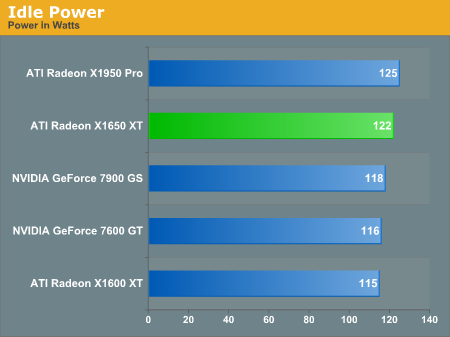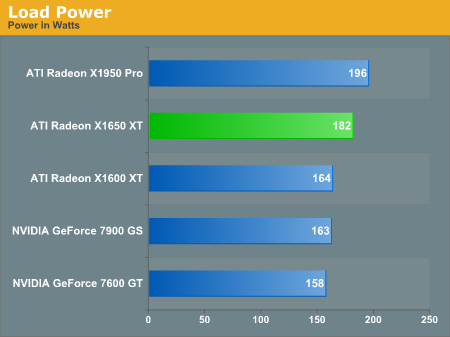Introducing the Radeon X1650 XT: A New Mainstream GPU from ATI
by Josh Venning on October 30, 2006 6:00 AM EST- Posted in
- GPUs
Power
Power consumption is always an important factor when looking at how a graphics card performs, and we did some tests here to determine how the X1650 XT compares to a few other key cards currently on the market. Even though these cards we tested are reference cards, we can still get a general idea of how much power they will use compared to one another. Of course, any card's power consumption has potential to increase or decrease depending on the different tweaks the individual vendors will make to them before shipping them out.

For these tests we start with the total power draw of the system with each of the cards installed while idle (no programs running). We chose these five cards because they include a general range of performance relative to the X1650 XT. We can see here that the X1950 Pro and X1650 XT are a little more power hungry than the rest of the cards at idle.

Next we look at the total power draw of the system while running some stress tests on each of the GPUs. The stress test we use is a few of the demos from 3dMark06, which are particularly graphics intensive. We see by this graph that the X1950 Pro is the most power hungry of these cards, which is to be expected given its level of performance. We also see that the X1650 XT has a more substantial power draw than any of the others, and in particular the 7600 GT, which shows to be the least power hungry of the five. The fact that the 7600 GT consumes less power than the X1650 XT is important, as these two cards are direct performance competitors. But again, keep in mind that these are reference cards and there will be some variation between power levels of the different vendor cards using these chipsets.
One nice thing about the X1650 XT is that it doesn't require an external power connection. This makes it a good choice for those with limited connections on their power supplies. However, the 7600 GT also doesn't need an external power connection, so our data might persuade those who are very concerned about power consumption to look into this card instead of the X1650 XT. 6W more power at idle and 24W more power at load (relative to the 7600 GT) shows that NVIDIA still holds a clear advantage when it comes to power requirements. However, the X1650 XT isn't a very power hungry card, so most users won't need to worry about its consumption. Worst case, 24W extra power use running 24/7 over the course of the year would still only amount to around $20. In the mobile market, however, ATI hardware still looks set to be at a disadvantage, as even a couple watts can be significant when you're looking at battery life.
Power consumption is always an important factor when looking at how a graphics card performs, and we did some tests here to determine how the X1650 XT compares to a few other key cards currently on the market. Even though these cards we tested are reference cards, we can still get a general idea of how much power they will use compared to one another. Of course, any card's power consumption has potential to increase or decrease depending on the different tweaks the individual vendors will make to them before shipping them out.

For these tests we start with the total power draw of the system with each of the cards installed while idle (no programs running). We chose these five cards because they include a general range of performance relative to the X1650 XT. We can see here that the X1950 Pro and X1650 XT are a little more power hungry than the rest of the cards at idle.

Next we look at the total power draw of the system while running some stress tests on each of the GPUs. The stress test we use is a few of the demos from 3dMark06, which are particularly graphics intensive. We see by this graph that the X1950 Pro is the most power hungry of these cards, which is to be expected given its level of performance. We also see that the X1650 XT has a more substantial power draw than any of the others, and in particular the 7600 GT, which shows to be the least power hungry of the five. The fact that the 7600 GT consumes less power than the X1650 XT is important, as these two cards are direct performance competitors. But again, keep in mind that these are reference cards and there will be some variation between power levels of the different vendor cards using these chipsets.
One nice thing about the X1650 XT is that it doesn't require an external power connection. This makes it a good choice for those with limited connections on their power supplies. However, the 7600 GT also doesn't need an external power connection, so our data might persuade those who are very concerned about power consumption to look into this card instead of the X1650 XT. 6W more power at idle and 24W more power at load (relative to the 7600 GT) shows that NVIDIA still holds a clear advantage when it comes to power requirements. However, the X1650 XT isn't a very power hungry card, so most users won't need to worry about its consumption. Worst case, 24W extra power use running 24/7 over the course of the year would still only amount to around $20. In the mobile market, however, ATI hardware still looks set to be at a disadvantage, as even a couple watts can be significant when you're looking at battery life.










33 Comments
View All Comments
Lonyo - Monday, October 30, 2006 - link
The X1950Pro can also be had in the US for $200 now from various websites, even if the prices at the top of this article show otherwise.Lonyo - Monday, October 30, 2006 - link
http://www.newegg.com/Product/Product.asp?Item=N82...">Sapphire X1950 Pro - in stock - $199
http://www.zipzoomfly.com/jsp/ProductDetail.jsp?Pr...">Sapphire X1950 In stock $205
Then there are 3 OOS at ZZF for $199.
http://www.amazon.com/Express-Radeon-X1950PRO-256-...">$188 from Amazon, apparently
DerekWilson - Monday, October 30, 2006 - link
tweaked that sentence to reflect current pricing.